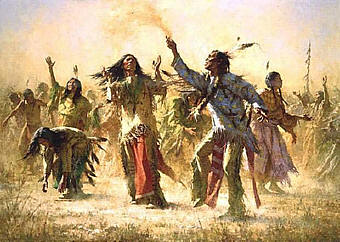He instructed his followers to dance a nocturnal circle dance. This dance was similar to both older Paiute traditions and an earlier regional movement, the Plateau Prophet Dance, but it addressed very present conditions of deprivation resulting from white incursions into tribal territories. It spread to California, Oregon, and Idaho

The Shoshone and Bannock of Fort Hall, Idaho, however, continued to perform the Ghost Dance at least intermittently up to 1890.
The Ghost Dance of 1890: Wovoka (ca.1856-1932), a Paiute Native American prophet, inaugurated the Ghost Dance of 1890 on the basis of a vision he had received during a total eclipse of the sun. His message was in direct continuity with the 1870 dance: there was to be an immanent renewal of the world in which dead Native Americans would be resurrected and the living would no longer be subject to sickness and old age, game animals would be restored to their former abundance, and the old way of life would once more flourish.
Euro-Americans, by this time firmly in control, would be eliminated by supernatural means, such as a flood or earthquake. It is uncertain whether Wovoka announced a specific date for these events, but many expected them in the spring of 1891. Wovoka's message also contained ethical admonitions (e.g., members of different tribes should live in peace with each other; they should cooperate with, not war against, the whites). In anticipation of the great event and to speed its arrival, Wovoka instructed his followers to perform circle dances periodically. They did so in large numbers, and (especially among Plains tribes) dancers often fell into trances, subsequently reporting that they had visited the spirit world and spoken with dead relatives, who were living a life like the one that had flourished before the coming of the whites. The 1890 dance spread mainly eastward along the length of the Rocky Mountains and Great Plains.
In some tribes (e.g., Paiute, Cheyenne, Shoshone, Pawnee) acceptance was almost unanimous; in others (like the Sioux) only segments of the population became believers. No Pueblo (except at Taos) or Navajo accepted it, the latter because of a culturally conditioned aversion to ghosts.
As news of the Paiute prophet Wovoka began to spread, tribes sent delegations to the Walker Lake Reser-vation in western Nevada to see him. They returned with versions of his teachings that were sometimes shaped by the particular needs of their tribe. Among the Pawnee, the dance provided the basis for an important cultural renewal, for the visions of the dancers made possible the revival of old ceremonial activities that had fallen into disuse because knowledge of their correct performance had been lost. The Sioux, who had a number of current grievances against the government (e.g., loss of reservation lands, cuts in rations), altered Wovoka's message in the direction of greater hostility toward the whites.
Delegates like Short Bull and Kicking Bear advocated the use of "ghost shirts" (special garments that were supposed to make the wearer invulnerable to bullets) and spoke of the possibility of armed conflict with the government soldiers. During 1890, newspapers around the country carried often sensational stories about the "messiah craze" (Wovoka was often called the "Indian messiah") and the possibility of renewed warfare with the Sioux.
Violence did erupt in December: during an attempt to arrest him, Chief Sitting Bull was shot to death, and Chief Big Foot and almost three hundred of his band were massacred by the cavalry at Wounded Knee. These events were more the result of government blunders than of a Sioux outbreak. Following the violence among the Sioux and the failure of the expected transformations the next spring, the popularity of the dance began to fade. However, it did not die out altogether. Wovoka remained active, but shifted his message in the direction of ethical admonitions. As late as 1896 some Kiowa were still dancing, and one of the early Northern Cheyenne delegates, Porcupine, led a brief revival of the dance in 1900.
The movement continued elsewhere in a more substantive way. In the first decade of the twentieth century, Fred Robinson, an Assiniboin who had been instructed in the Ghost Dance by Kicking Bear and had corresponded with Wovoka, brought the dance to a small community of Sioux living in Saskatchewan. Combined with a traditional Medicine Feast, apocalyptic elements disappeared and the themes of ethical admonition and community solidarity predominated.
Among the Wind River Shoshone (Wyoming), the Ghost Dance apparently combined with an earlier ceremony (the Father Dance) of thanksgiving to God for food. As a result, the annual renewal of nature took on a cosmic dimension: shamans reported dreams in which they saw the dead assembled in heaven waiting to return to earth at some unspecified time in the future. The people on earth anticipated this event and performed a dance thought to imitate that of the dead.
In both these places the Ghost Dance continued to be performed into the 1950s. In the 1970s the dance was revived by the activist American Indian Movement. Even among persons and groups who no longer practice it, knowledge of the Ghost Dance has not died out and lessons are still derived from it. Thus ca. 1970 the Sioux medicine man Lame Deer reinterpreted an old Ghost Dance song about straightening arrows and killing and butchering buffalo to mean that individuals must live upright lives in order to help bring about a new earth.